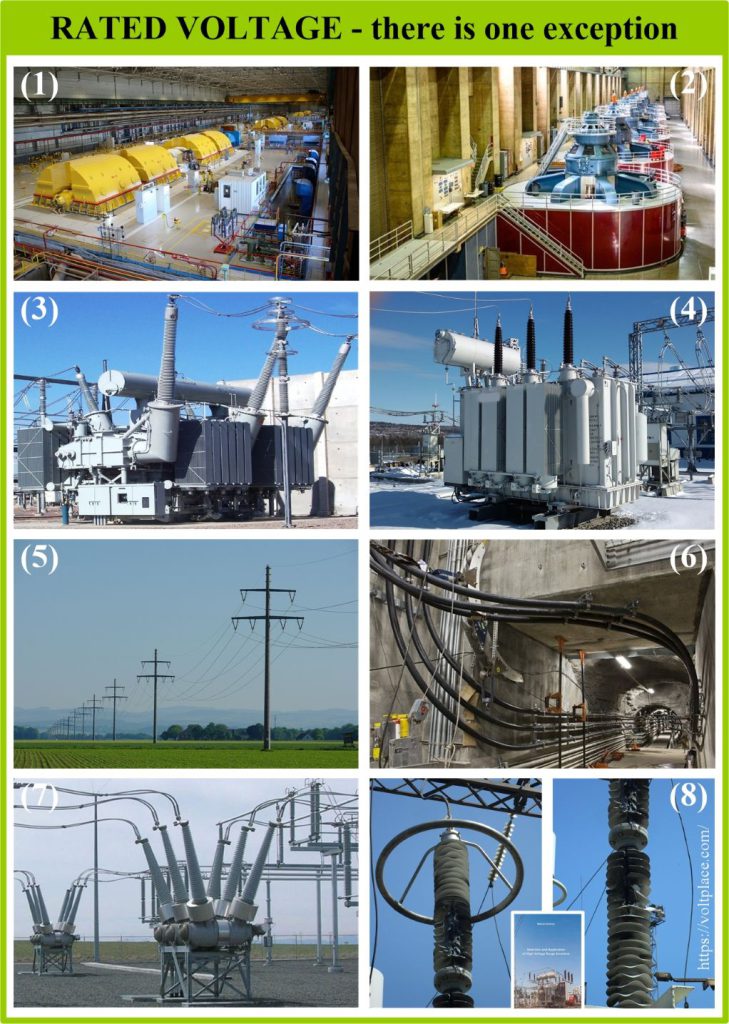
Rated voltage of surge arrester
The main characteristics of the three-phase AC network are its voltage class, frequency, and method of neutral grounding. Speaking of voltage, there are two different voltages (the designations may depend on the country):
✅ Rated voltage (let it be Ur);
✅ Maximum continuous operating voltage (let it be Umcov).
Both voltages are the effective value of the voltage between phases, which can exist in the network for at least 30 years. However, Ur is a kind of median voltage value and is more often used to classify networks, while Umcov is more specific and characterizes the limiting voltage. For most networks, depending on their features, Umcov can usually be 5-20% higher than Ur.
There is a similar voltage classification (let it be Ur, Umcov) not only for the network itself, but also for the equipment and lines used in the network. For example, it is so for the following key AC network equipment:
1️⃣ Turbo generators;
2️⃣ Hydro generators;
3️⃣ Autotransformers;
4️⃣ Power transformers;
5️⃣ Overhead lines;
6️⃣ Cable lines;
7️⃣ Circuit breakers, disconnectors, instrumental transformers etc.

Here, of course, we need to note that some of the items (for example, autotransformers, cables, circuit breakers etc.) may have a single-phase design, and, in this case, they are better characterized by phase-to-ground values Ur/1.73 and Umcov/1.73. However, this does not change the two basic rules of the game:
✅ Ur and Umcov are for 30 years and even more;
✅ Ur and Umcov are always in the ratio Ur<Umcov.
Unfortunately, there is one type of equipment that “spoils” the whole rules:
8️⃣ Surge arrester (without spark gap).
For a surge arrester 8️⃣, the rated voltage Ur is the voltage that it can withstand for only 10 seconds. Because of this, many mistakes were made all over the world, since sometimes people could not even imagine that Ur was not for 30 years, but for only 10 seconds. Today, by my post, I would like to support such people and express my disagreement with this situation.
As a tester of high-voltage equipment, as the head of the technical department of a plant producing surge arresters, as a professor at a leading university in the country, I saw the same thing: “rated voltage Ur of the gapless surge arrester” should be excluded from the regulatory documents and arresters’ specifications.
As a person who has been directly involved in transients, overvoltages and protection against them for 25 years, I can say that the “rated voltage Ur of the gapless surge arrester” is not only a useless, but also a harmful parameter. And with many of my colleagues we dream that the arresters will one day return to a large, friendly family of normal equipment where:
✅ Rated voltage (Ur) – for 30 years;
✅ Maximum continuous operating voltage (Umcov) – for 30 years, and it is always true that Ur<Umcov;
✅ The ability to withstand the AC 50 Hz voltage rise above Umcov is described by the voltage-time characteristic (without highlighting any single point as 10 sec or another).
AFTERWORD 1
Well, for those who really love the concept of Ur that exists for arresters and are ready to fight for it to the end, I suggest to answer the following questions:
➡️ What processes last in the network for exactly 10 seconds?
➡️ Why didn’t all equipment manufacturers, which are required to check insulation with an increased AC 50 Hz voltage for 1 minute, name this voltage Ur and indicate it on the label?
Answers are:
➡️ There are no such processes;
➡️ Because they don’t want to confuse people.
Dear developers of IEC 60099, please bring surge arresters back to the big family of all the equipment, and adjust the arrester’s norms so that Ur is for 30 years, and not for 10 seconds. We don’t want to hear that it’s impossible. Major industries (1)-(7) have been able to use proper Ur for their equipment, and you definitely will be able to do the same.
AFTERWORD 2
If road accidents happen at the same place all the time, then of course we can blame the drivers. But maybe it’s because there aren’t enough road signs or the driving rules are not written in the best way?
